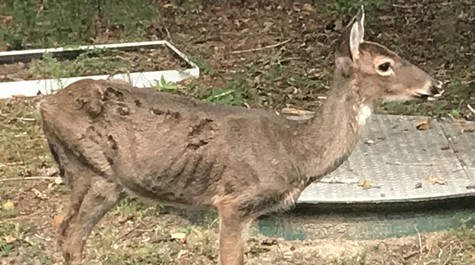Wet summer, biting midges spread deadly disease among deer
A rash of deer deaths in the College Woods is likely the result in an overabundance of biting midges, according to Randy Chambers, director of William & Mary’s Keck Environmental Laboratory.
“We've had a wet couple of months and a bunch of mosquitoes and other small, blood-sucking insects — midges — have hatched out,” Chambers said in an email. “It looks like some of them are carrying a virus that causes epizootic hemmorhagic disease (EHD) in our local, overly abundant deer population.”
Chambers said that neither EHD nor the closely related disease called bluetongue can be caught by humans. He added that he doesn’t know much about the disease, and said he was getting information from a Virginia Department of Wildlife Resources website. But he added that the hooved victims of EHD are numerous on and around campus.
“In the 20 years that I’ve been here, I’ve seen dead deer before, but it just seems that they’re everywhere right now,” he said. “My assistant was pulling into a parking space this morning and she stopped because there was a deer in her parking space, just sitting there, trembling. And that’s not normal.”
So far, the reports of dead and dying deer have been restricted to the heavily wooded areas of campus, an area that begins at Crim Dell, then stretches down the Lettie Pate Evans Wildflower Refuge and into the College Woods that surround Lake Matoaka and beyond, to the other side of Monticello Road. Chambers said six dead deer were found close together in one small area.
Chambers said the situation is not restricted to the William & Mary campus, and he added that he has detected evidence of decomposing deer while running on trails around Williamsburg.
The DWR reports a variable outbreak of EHD/bluetongue each year, usually in late summer or early fall. Chambers observed that the more severe outbreaks often coincide with drought years, not the case for wet 2020.
“In a drought, the deer will go down to the wetlands, where the midges hatch out of the mud,” he said. “This year, with all the rain, it looks like the wetlands went to the deer.”
If you encounter a sick-looking deer, Chambers and the DWR both say you should leave it alone. The DWR asks that you report sick and dead deer to its Charles City office at 804-829-6580. Dead deer on campus should be reported to Facilities Management Work Control at 757-221-2270. An animal that looks as if it needs to be euthanized should be reported to the William & Mary Police Department at 757-221-4596.
 Skip to main content
Skip to main content

